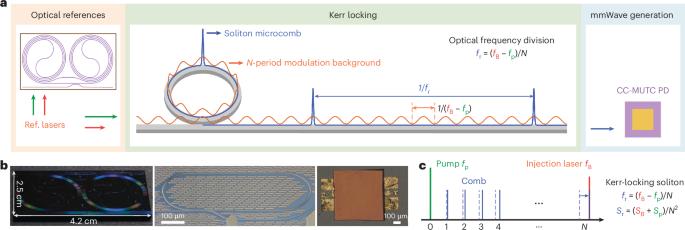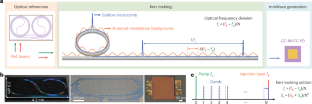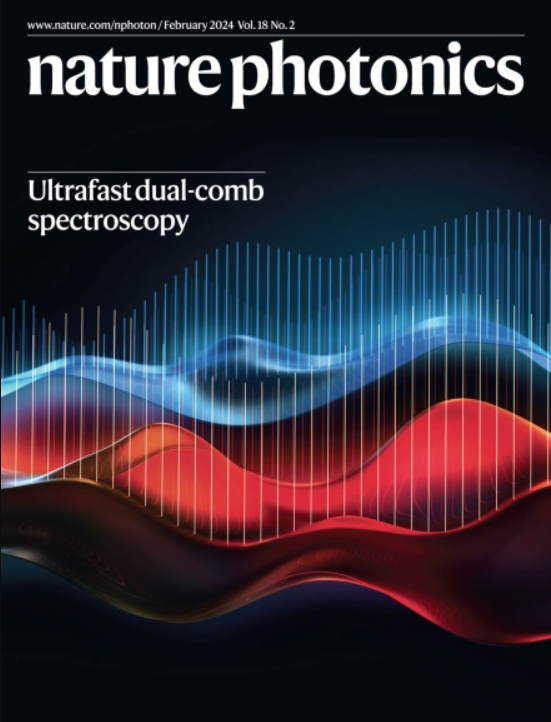Microcavity Kerr optical frequency division with integrated SiN photonics
IF 32.9
1区 物理与天体物理
Q1 OPTICS
引用次数: 0
Abstract
Optical frequency division has revolutionized microwave and millimetre-wave generation and set spectral purity records owing to its unique capability to transfer high fractional stability from optical to electronic frequencies. Recently, rapid developments in integrated optical reference cavities and microresonator-based optical frequency combs (microcombs) have created a path to transform optical frequency division technology to the chip scale. Here we demonstrate an ultralow-phase-noise millimetre-wave oscillator by leveraging integrated photonic components and microcavity Kerr optical frequency division. The oscillator derives its stability from an integrated complementary-metal–oxide–semiconductor-compatible SiN coil cavity, and the optical frequency division is achieved spontaneously through Kerr interaction in the integrated SiN microresonator between the soliton microcombs and the injected reference lasers. Besides achieving low phase noise for integrated millimetre-wave oscillators, our demonstration greatly simplifies the implementation of integrated optical frequency division oscillators and could be useful in applications of radar, spectroscopy and astronomy. By leveraging microcavity-integrated photonics and Kerr-induced optical frequency division, an integrated photonic millimetre-wave oscillator with low phase noise is demonstrated, achieving –77 dBc Hz–1 and –121 dBc Hz–1, respectively, at 100-Hz and 10-kHz offset frequencies, corresponding to –98 dBc Hz–1 and –142 dBc Hz–1 when scaled to a 10-GHz carrier.


集成SiN光子学的微腔克尔光分频
光分频已经彻底改变了微波和毫米波的产生,并设置了光谱纯度记录,由于其独特的能力,将高分数稳定性从光学频率转移到电子频率。近年来,集成光学参考腔和基于微谐振器的光频梳(microcomb)的快速发展为光分频技术向芯片规模的转变开辟了道路。在这里,我们展示了一个超低相位噪声毫米波振荡器利用集成光子元件和微腔克尔光分频。该振荡器的稳定性来源于互补-金属-氧化物-半导体兼容的集成SiN线圈腔,光分频是通过集成SiN微谐振腔中孤子微梳和注入参考激光器之间的克尔相互作用自发实现的。除了实现集成毫米波振荡器的低相位噪声外,我们的演示大大简化了集成光分频振荡器的实现,可以在雷达,光谱学和天文学的应用中使用。
本文章由计算机程序翻译,如有差异,请以英文原文为准。
求助全文
约1分钟内获得全文
求助全文
来源期刊

Nature Photonics
物理-光学
CiteScore
54.20
自引率
1.70%
发文量
158
审稿时长
12 months
期刊介绍:
Nature Photonics is a monthly journal dedicated to the scientific study and application of light, known as Photonics. It publishes top-quality, peer-reviewed research across all areas of light generation, manipulation, and detection.
The journal encompasses research into the fundamental properties of light and its interactions with matter, as well as the latest developments in optoelectronic devices and emerging photonics applications. Topics covered include lasers, LEDs, imaging, detectors, optoelectronic devices, quantum optics, biophotonics, optical data storage, spectroscopy, fiber optics, solar energy, displays, terahertz technology, nonlinear optics, plasmonics, nanophotonics, and X-rays.
In addition to research papers and review articles summarizing scientific findings in optoelectronics, Nature Photonics also features News and Views pieces and research highlights. It uniquely includes articles on the business aspects of the industry, such as technology commercialization and market analysis, offering a comprehensive perspective on the field.
 求助内容:
求助内容: 应助结果提醒方式:
应助结果提醒方式:


